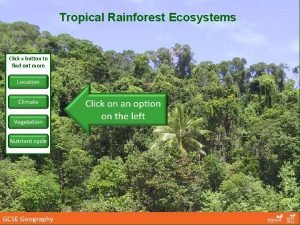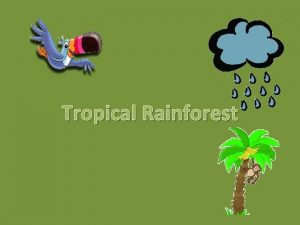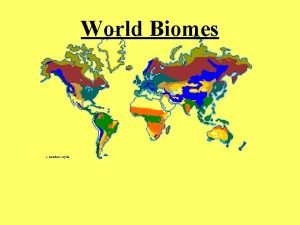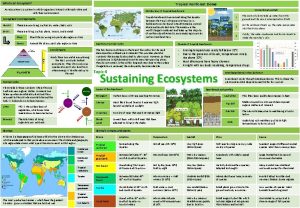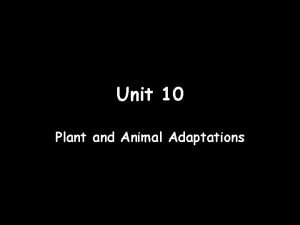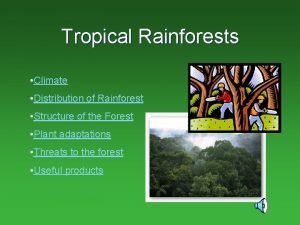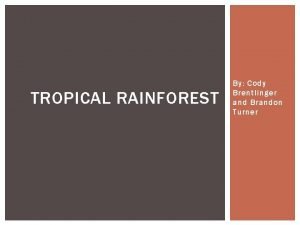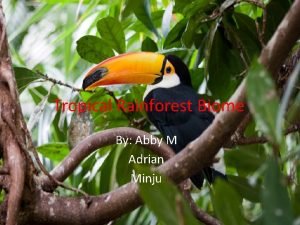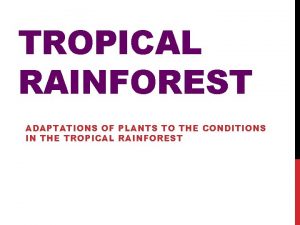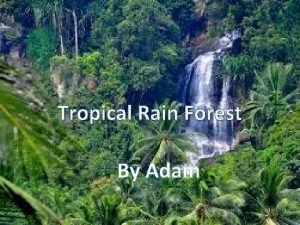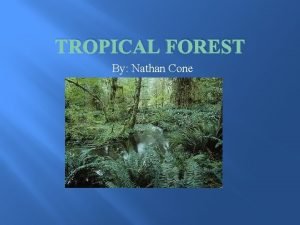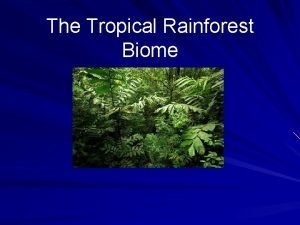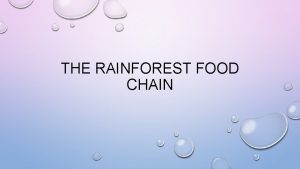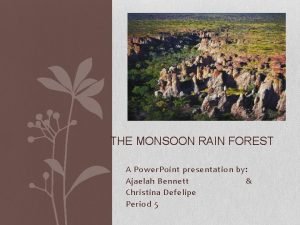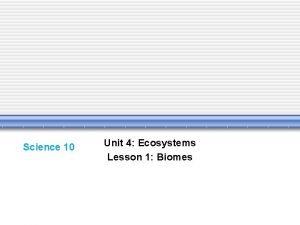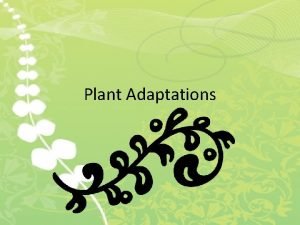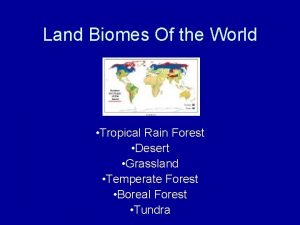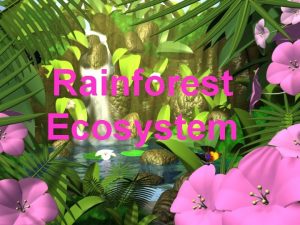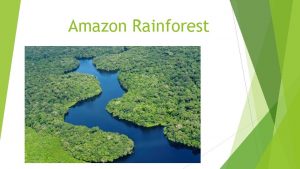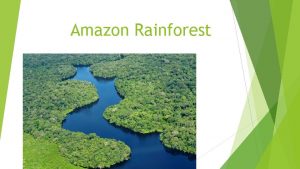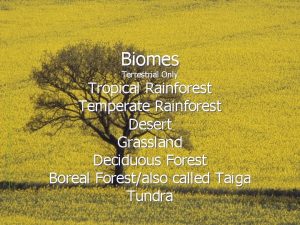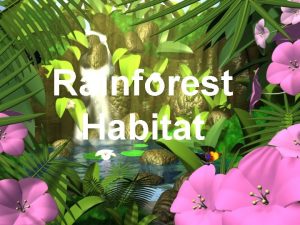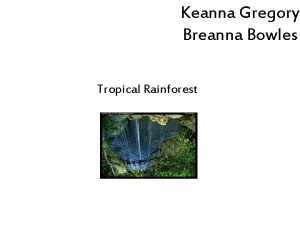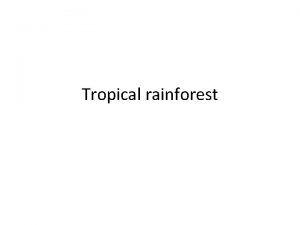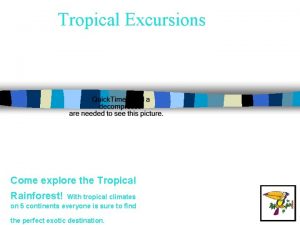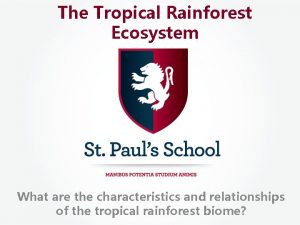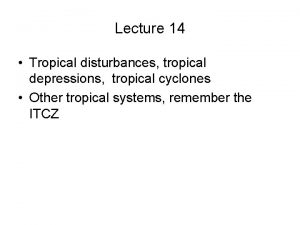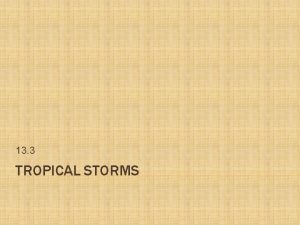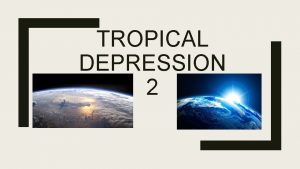Tropical Rainforest Ecosystem Is a localized group of

















- Slides: 17

Tropical Rainforest

Ecosystem: Is a localized group of interdependent organisms together with the environment that they inhabit and depend on.

Abiotic: relating to non-living parts of an environment such as sunlight, soil, moisture, and temperature. Biotic: Relating to living organisms such as plants, animals, fungi, and bacteria.

Biotic Abiotic Alligators Average temp. 20 -34*C Amphibians Located close to equator Piranha Warm air can hold lots of water Sloth Annual rainfall of 250 cm Turtle Average humidity 77 -88%

Biotic Trees Pineapple Pepper Orange Banana Nuts

Population: all the members of a specific species within an ecosystem. An example of population in the tropical rainforest is the toucan population.

A rainforest community not near the rivers would contain some toucans, apes, monkeys, grasshoppers, and some snakes.

Interactions of Organisms in the Tropical Rainforest • Symbiotic Relationships: A symbiotic relationship is a relationship between two entities which is mutually beneficial for the participants of the relationship. • Commensalism: A symbiotic relationship in which one species benefits and the other species is neither helped nor harmed. • An example of commensalism in the tropical rainforest is vermiliads and frogs. The frogs get protection from the rain from the verlilliads. • Mutualism: A symbiotic relationship between two organisms in which both organisms benefit. • An example of Mutualism Leaf cutter ants live underground in the rainforest and have a mutualistic relationship with a fungus there. The ants cut the chunk of leaves from trees even though they cannot actually digest the plant matter. They bring this plant matter back to the nest and cultivate a fungus. The fungus is fed by the plant matter from the ants, and in turn it provides food for the ants.

Parasitism: Is a symbiotic relationship in which one species benefits and the other is harmed. An example of Parasitism is a Strangler fig grows on the branches of a tree and then the strangler fig eventually sprouts aerial roots. Over time, many roots may grow and then will wrap around the tree resulting in death of the tree.

Lizard Boa A predator prey relationship in the tropical rainforest is the boa constrictor and lizards.

Niche • An example of a niche in the rainforest is the bees that pollinate all of the different plants.

Tertiary consumers Secondary consumers Primary consumers Producers

Trophic levels Primary Producers: organisms in the first trophic level, such as plants and algae Primary Consumers: Organisms in the second trophic level which obtain their energy by eating primary producers. (Ex’s are grasshoppers, zooplankton) Secondary Consumers: Organisms in the third trophic level which obtain their energy by eating primary consumers. (Ex’s are frogs and crabs) Tertiary Consumers: organisms in the fourth trophic level obtain their energy by eating secondary consumers. (Ex’s are Killer Whales and Eagles)

Endangered species Golden Lion Tamarind Monkey Toucans and Parrots Jaguar Poison Dart Frog

Fun Facts • The tropical rainforest has the most populations in it because rainforests are the oldest ecosystem on earth.

An area of a rainforest the size of a football field is being destroyed each second. 1 out of 4 ingredients in our medicine is from rainforest plants. Some rainforest monkeys are omnivores, eating both animals and plants

By: Samuel Whitelaw KYLE CLARK
 Tropical rainforest ecosystem
Tropical rainforest ecosystem Primary consumers in the tropical rainforest
Primary consumers in the tropical rainforest Bougainvillea tropical rainforest
Bougainvillea tropical rainforest Tropical rainforest biome location
Tropical rainforest biome location Camel adaptations
Camel adaptations Gersmehl model tropical rainforest
Gersmehl model tropical rainforest Tropical rainforest climatogram
Tropical rainforest climatogram Food web of tropical rainforest
Food web of tropical rainforest Adaptations of lianas
Adaptations of lianas Tropical rainforest food web
Tropical rainforest food web Energy pyramid for tropical rainforest
Energy pyramid for tropical rainforest What is the climate of the tropical rainforest biome
What is the climate of the tropical rainforest biome Anaconda food chain diagram
Anaconda food chain diagram What is a monsoon forest
What is a monsoon forest Tropical rainforest biome brochure example
Tropical rainforest biome brochure example Plants in tropical rainforest adaptations
Plants in tropical rainforest adaptations Rainforest and desert venn diagram
Rainforest and desert venn diagram Food web of the tropical rainforest
Food web of the tropical rainforest
